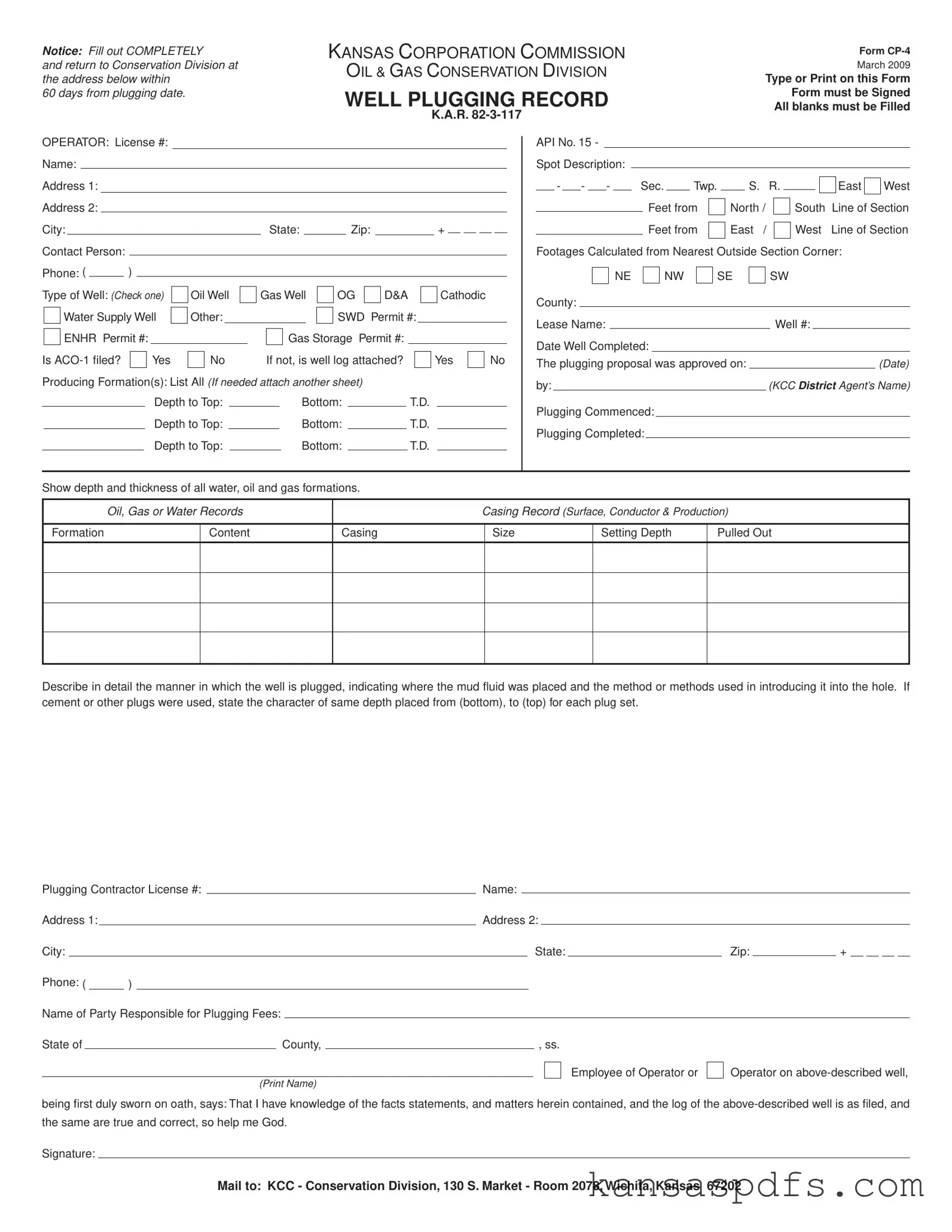What is the purpose of the Kansas CP-4 Form?
The Kansas CP-4 Form is designed for the detailed recording of well plugging activities. Operators are required to fill this form completely and submit it to the Conservation Division within 60 days from the plugging date. Its primary purpose is to ensure that the plugging of wells, be it oil, gas, water supply, or any other type, complies with state regulations to protect the environment and public health.
Who is required to complete the CP-4 Form?
Operators of wells, including oil wells, gas wells, water supply wells, and others specified in the form, are required to complete the CP-4 Form. It's essential for any operator who has commenced plugging activities to accurately record these actions and submit the requisite information to the Kansas Corporation Commission.
How should the CP-4 Form be filled out?
The form must be typed or printed clearly to ensure legibility. Every section of the form must be completed, with all blanks filled in. The form requires detailed information on the well, including the type of well, permit numbers, well location, plugging dates, and details of the plugging process. If additional space is needed for any section, attach another sheet with the corresponding details.
What happens if the well log is not filed with the ACO-1 form?
If the ACO-1 form has not been filed, the operator is required to attach the well log to the CP-4 Form. The well log provides a detailed record of the geological formations encountered during the drilling of the well and is crucial for assessing the adequacy of the plugging activities.
Is there a deadline for submitting the CP-4 Form?
Yes, there is a deadline. The completed form must be returned to the Conservation Division at the specified address within 60 days from the plugging date of the well. Timely submission is crucial to comply with Kansas regulations and to avoid potential penalties.
What information is required about the plugging contractor?
Information on the plugging contractor includes the license number, name, address, and phone number. This ensures accountability and provides the Conservation Division with the necessary details to contact the contractor if further information about the plugging process is needed.
How detailed must the plugging information be?
The form requires a comprehensive account of the plugging process. Operators must describe in detail how the well was plugged, including the depths and thicknesses of all water, oil, and gas formations, the types of plugs used, and the placement of mud fluid and cement or other materials. This detailed reporting is essential for verifying the proper isolation of producing formations and the protection of freshwater aquifers.
Who is responsible for the plugging fees?
The name of the party responsible for the plugging fees must be included in the form. This could be the operator or another designated party. Identifying the responsible party ensures that the Kansas Corporation Commission knows who to contact regarding any financial obligations related to the well's plugging.
What is required for the signature section of the CP-4 Form?
The form must be signed by an employee of the operator or the operator themselves, who is duly sworn on oath to attest that the information provided in the form and the well log is true and correct. This affirmation under oath is a legal assurance of the accuracy and completeness of the submitted information.
Where should the completed CP-4 Form be mailed?
The completed form should be mailed to the KCC - Conservation Division at 130 S. Market - Room 2078, Wichita, Kansas 67202. It is important to ensure that the form reaches this address within the specified 60-day period following the well's plugging to meet regulatory requirements.

